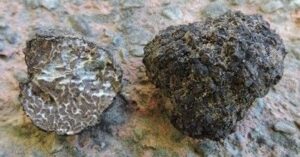Uncinatum

Scientific Name
Tuber uncinatum
Common Names
Burgundy Truffle
Seasons
September – January in Northern Hemisphere
Description
More tolerant to cold than T. melanosporum, T. uncinatum has been shown to be the same species as the T. aestivum however they differentiate enough in term of seasonality, appearance and flavor to keep them separated on Truffle Board. With bodies (ascocarps) from 2 to 10 centimeters (1 to 4 inches) in diameter, burgundy truffles are relatively large. Their brown or black outer skin (peridium) forms pyramidal warts about 3 to 9 mm wide, resembling rough bark.
Aroma/Flavor
They have an intense, hazelnut-like aroma (more intense than T. aestivum) and are highly prized for their gastronomic qualities. Because of their delicate flavor they are used in the haute cuisine of France and Italy, as a substitute for T. melanosporum.
Distribution
They have a wider natural distribution than any other truffle species. Burgundy truffles are found across Europe, from Spain to eastern Europe and from Sweden to North Africa. In France they are found mainly in the north and north-east of Italy. In the United Kingdom they were plentiful prior to the 20th century, but are now rare. Their distribution may not yet be definitively established as in 2007 there were unconfirmed reports of finding it in China.
Farmed in France, Spain, Italie, Australia, New Zeland, Chile, USA, Argentina, England.
See grading guidelines
Other species
- Tuber aestivum (black summer truffle)
- Tubber Borchii (bianchetto)
- Tuber Brumale (Muscato truffle)
- Kalapuya Brunea (Oregon brown truffle)
- Leucangium carthusianum (Oregon black truffle)
- Tuber canaliculatum (Appalachian truffle)
- Tuber gibbosum (Oregon white truffle)
- Tuber lyonii (pecan truffle)
- Tuber macrosporum (smooth black truffle)
- Tuber magnatum (white truffle)
- Tuber melanosporum (Perigord truffle)
- Tuber oregonese (Oregon white truffle)
- Tuber uncinatum (Burgundy truffle)

